ATH-AD700X
back to audio-technica
back to measurements
home
published: Oct-24-2022
NO SMOOTHING is applied to the shown plots. Most measurement sites have some smoothing applied which ‘irons flat’ sharp peaks and ‘wiggles’. I do not use smoothing because some info about sound quality is lost when plots are smoothed.
Aside from a small correction of the microphone itself also some correction in the lowest frequencies is applied to the plots to compensate for the perceived loss of bass when using headphones. This is described HERE in more detail.
A ‘horizontal‘ frequency response curve on the shown frequency response plots on this website thus indicates a perceived ‘flat’ tonal signature.
ALL measurements are made with a good SEAL on a flatbed measurement rig.
The shape of your head, bone structure, pad size, pad ‘softness, (compliance), hair or no hair and or wearing glasses may (drastically) change the frequency response of some headphones, so… your personal experience may differ substantially from these plots.
Frequency response (tonal balance) is the most sound-determining aspect of headphones. A horizontal line shows audible neutral response in the plots on this website. Deviations in different severity at different frequency bands have an effect on the sound character.
The bigger the deviation the stronger the effect.
Below an aid to help determining the sound character of headphones with relation to the frequency response.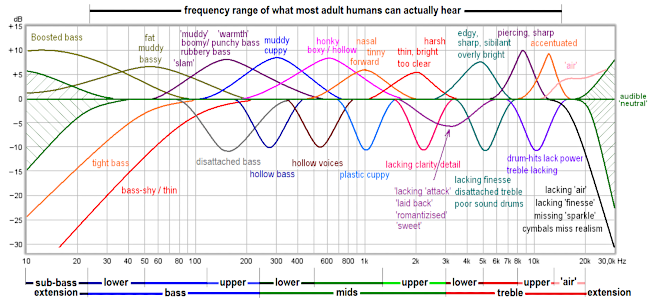
audio-technica ATH-AD700X
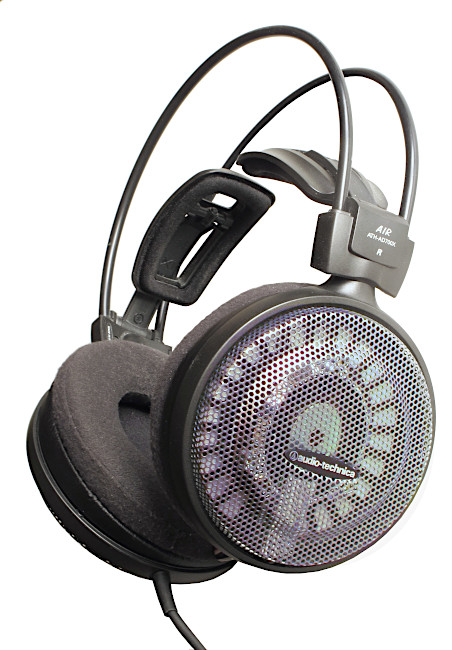
The audio-technica ATH-AD700X is an open over-ear headphone. When this headphone came out (around 2014 as successor of the ATH-AD700) the MSRP was around € 200.- and still is end 2022.
It is very light-weight and comfortable. It looks ‘technical’.
The 3m cable is only very mildly microphonic, smooth and a bit ‘springy’ and terminates in a straight 3.5mm plug. A 6.3mm push-on adapter is supplied with it. The cable is fixed so cannot be replaced.
This headphone does not have the usual headband as seen in most headphones. The ATH-A700X uses the ‘wing type’ headrests that do not sit on top of the head but rest against the sides of the head.
This takes some getting used to and kind-of works a bit better than in the previous version.
The cups have some swivel but strangely enough no tilt. This means the angle of the cups is solely determined by the width of the head. People with narrow or wider heads may not be able to get a good seal and the pads may be ‘leaking’ at the top or bottom side. A very strange construction. The closed version (ATH-A700X) does have a mechanism that allows tilt.
The plastic ‘creaks’ a little when adjusting it on the head but not while wearing it.
The cloth pads are changeable and feel very soft to the touch. There is ‘normal’ foam inside the pads. The weirdest thing about these pads is the integrated dust filter. This makes the pad depth 20mm and a bit less when the soft pads are compressed. The internal diameter is merely 51mm though so there is not a lot of room inside for all ear sizes. After a few hours of wearing it became uncomfortable.
The pads themselves are also shaped to follow the contours of a real head which is not seen that much.
It is an open headphone so outside noises are not attenuated much.
With a sensitivity of 117dB/V (efficiency = 102dB/mW) and low impedance (36 Ω measured) this headphone plays very loud even directly from a phone.
This reviewed audio-technica ATH-AD700X is for sale.
specifications:
Type: Over ear (circum-aural), open
Usage: Home, portable (but not outdoors)
Driver type: dynamic
Pads: replaceable, cloth, regular foam
Collapsible: no
Headphone cup connector: fixed
Cable entry: single sided (left).
Cable: 3m terminated in a gold-plated 3.5mm TRS jack with a 6.3mm adapter.
Inner Pad dimensions: depth = 20mm, diameter = 51mm.
Driver size: 53mm (angled 20°) effective diameter = 48mm
Max. power rating: 700mW (0.7W)
Max. voltage: 5Vrms (14Vpp)
Max. current: 140mA
Max. S.P.L.: 130 dB
Impedance: 36 Ω (measured)
Efficiency: 102dB @ 1mW
Sensitivity: 117dB @ 1V
Weight: 275 g. (without cable)
Clamping force: medium-low (4N)
Accessories: 6.3mm adapter
Subjective sound description:
Bass is low in level but not poor in quality. It is lacking bass extension so no deep rumbles anywhere.
When put on the head the sound signature sounds ‘off’ and a bit weird in tonality. Fortunately one gets used to the sound pretty quickly and sounds more ‘correct’ after a short while.
Mids do not sound very dynamic but also not lifeless but lack ‘bite’ and ‘clarity’. The mids thus have a ‘relaxed’ signature.
The treble is not accentuated. There is no sibilance but depending on the recording there can be sharpness. The treble sounds very distant yet ‘thin’ (a bit ethereal) and lacks power in the cymbals. The treble is not of high quality but not coarse nor grainy and does have the impression of being very detailed without much (but with some recordings a little) sharpness.
Stereo image, probably due to the substantially angled drivers is a bit wider/spacious than most other headphones but not exceptional.
Measurements:
Below the frequency response of the ATH-AD700X (Left, Right) 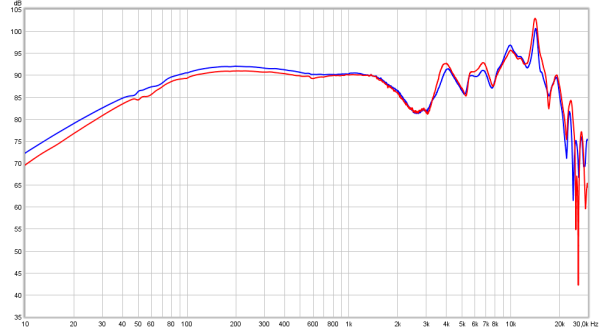
The channel matching is decent. Bass extension is absent and starts to drop-off below 100Hz.
This makes the bass a bit thin and lacking ‘body’. From 100Hz to 1.5kHz the response is pretty neutral. The dip between 2kHz and 4kHz is 7dB deep and quite audible and makes the sound a bit ‘weird’. Above 8kHz the treble starts to peak. At 10kHz it even reaches +5dB and at 14kHz +10dB but this is very narrow so not audible as such. This is responsible for a sharp contour in instruments (fake detail) and gives some sharpness. For people over 60 this treble peak won’t be objectionable and might even be an advantage.
compared to
Below the ATH-AD700X versus its closed (and no longer available) ATH-A700X.
Below, alternating every 5 seconds, the ATH-AD700X versus some other (mostly) open headphones.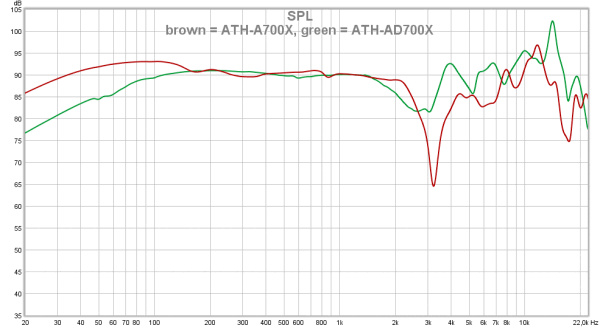
phase response
Below the phase response of the ATH-A700X (Left, Right)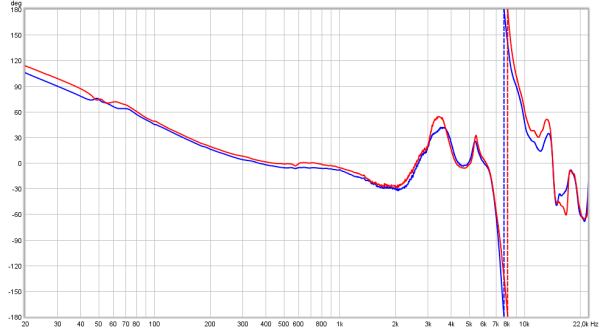
Slow phase shifts are not very audible. Sharp changes in a narrow frequency bands may well be audible. The sharp shifts at 5.5kHz and around kHz may well be audible and perhaps also responsible for the lesser treble quality.
output resistance / damping-factor
As this is a dynamic headphone the frequency response can be amplifier output resistance dependent when certain higher output resistance amplifiers are used.
Instead of showing impedance plots, which are hard to ‘read’ when it comes to assessing the tonal balance change in the real world, the ATH-A700X is measured via a few different resistance outputs (0.2Ω, 10Ω, 32Ω and 120Ω). On a higher output resistance amplifier the output level will be lower of course due to voltage division. To compensate for this the amplifier is cranked up to the same level (12.7dB for 120Ω at 1kHz in this case). This way the plots are overlaid and it is easier to see how the tonal balance changes. Output resistances between the mentioned resistance values will result in tonal changes between those traces.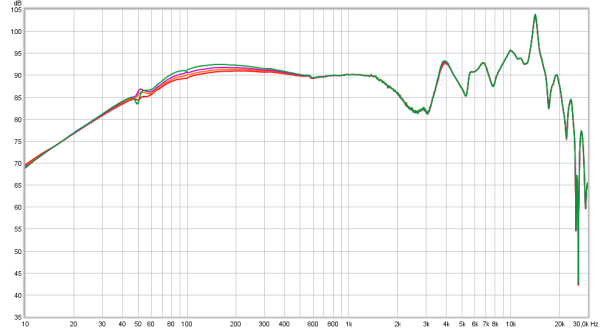 The tonal balance in the bass does not really change when a higher output resistance amplifier is used.
The tonal balance in the bass does not really change when a higher output resistance amplifier is used.
This headphone thus can be driven from just about any amp without a change in tonality.
With some high output resistance (tube) amplifiers or from the headphone out of integrated amps/AVR’s the slight emphasis of the lows makes it sound a bit warmer.
seal
Seal can be an issue with closed-back headphones. Breaking the seal (improper fit on the head) usually means a loss of (sub)bass. This can be caused by hair or glasses between head and pad or head shape.
Normal seal, seal broken with thick armed glasses flush with the skin, seal broken by thicker armed glasses that create some space between the pad and skin, seal broken by poor fit (gap on top or bottom side caused by the absence of tilt)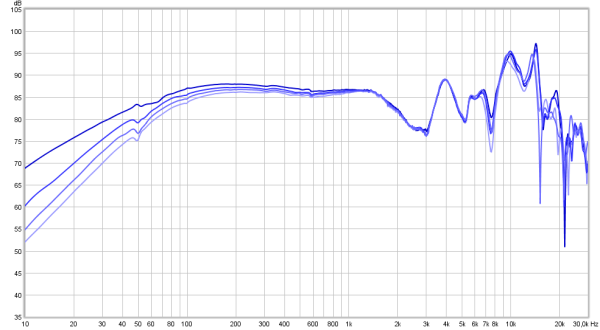 A broken seal has influence on the tonality of this headphone. A small seal breach results in a bit less bass extension. When the pads are lifted a bit (head width/size dependent) the little bit of bass there was also disappears.
A broken seal has influence on the tonality of this headphone. A small seal breach results in a bit less bass extension. When the pads are lifted a bit (head width/size dependent) the little bit of bass there was also disappears.
Below the distortion measurements of the ATH-A700X (Right channel).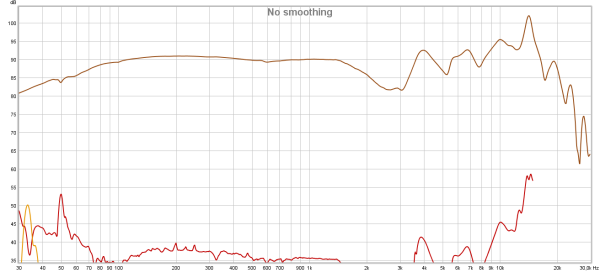 The measurements are made at 90dB SPL.The plot above shows the level differences between the signal (upper trace) and the harmonics.
The measurements are made at 90dB SPL.The plot above shows the level differences between the signal (upper trace) and the harmonics.
Most people prefer to see percentages instead of level differences so below the exact same plot except ‘normalized’ to the actual signal and level differences given in percentages.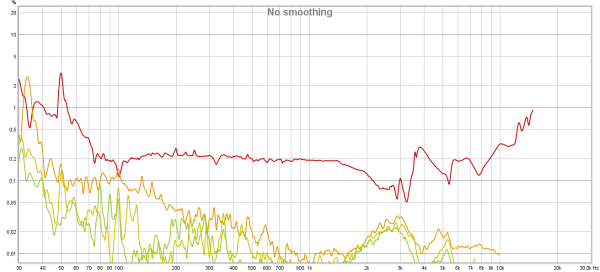 Distortion levels at 90dB SPL are not very high for a 53mm driver. Above 70Hz the distortion is very low.
Distortion levels at 90dB SPL are not very high for a 53mm driver. Above 70Hz the distortion is very low.
3rd harmonic distortion is very low.
The actual 2nd harmonic distortion above 1kHz may well be lower than 0.2% . A shortcoming of my measurement rig.
Because of the low distortion there also is no dynamic compression to at least 97dB SPL as shown below (note the 2dB/div scale). 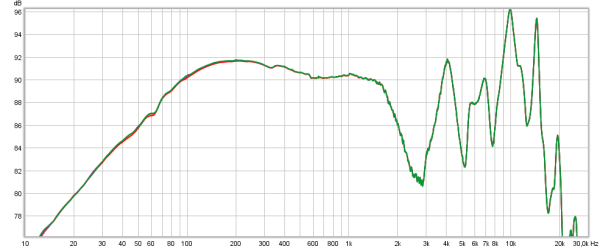
Below the CSD (waterfall) plot of the ATH-A700X. (Left and Right are overlaid)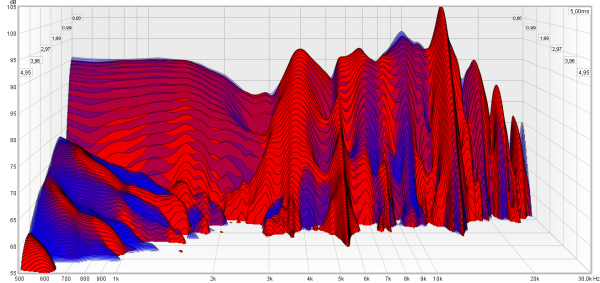 The big driver appears to have quite a few resonances at 4kHz, 5.5kHz and at 14kHz.
The big driver appears to have quite a few resonances at 4kHz, 5.5kHz and at 14kHz.
These are not long lasting though. The level peaking (or dipping) is more audible than the decay.
Below the Group Delay plot for the ATH-A700X (Left, Right)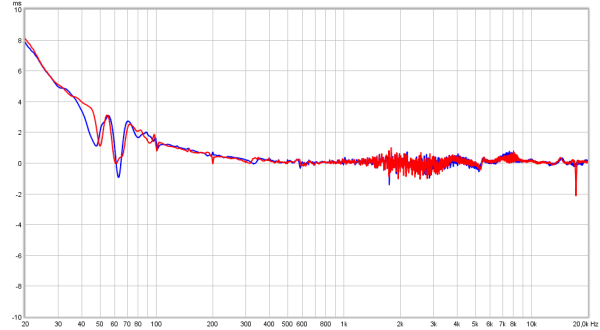
From 40Hz to 70Hz there is some small ‘pad bounce’. Otherwise there are no big red flags. The resonance at 5.5kHz and 14kHz are visible.
A different plot is the spectrum plot. This basically is a CSD (Waterfall) plot but viewed from above where the level differences are color coded instead of being in the vertical axis. Also the frequency range of the spectrum plot is wider (from 100Hz instead of 500Hz). The time span is also bigger in the spectrum plots and expired time is shown from below to top where in the CSD the time is shown from rear to front.
Below the spectrum plot of the ATH-AD700X (Right channel)  The decay at frequencies below 1kHz are really short. The low level ‘stuff’ between 1kHz and 5kHz is also seen in the GD plot and is actually noise being picked up from the room so measurement artifact rather than something from the headphone itself.
The decay at frequencies below 1kHz are really short. The low level ‘stuff’ between 1kHz and 5kHz is also seen in the GD plot and is actually noise being picked up from the room so measurement artifact rather than something from the headphone itself.
Step response
Below the step response plot which, when the sound is balanced and well extended should show a fast rise to around 0dB, (indicating fast driver response) and then should be slightly sloping downwards indicating bass extension. (Left, Right) The ‘midrange’ centric character of the AD700X is evident by the elevated area between 250μs and 800μs. The initial rise reaches -2dB which is the same level as the lower mids. The substantial ringing indicates poorer treble quality and the drop of signal after 1ms is evidence of the poor bass extension.
The ‘midrange’ centric character of the AD700X is evident by the elevated area between 250μs and 800μs. The initial rise reaches -2dB which is the same level as the lower mids. The substantial ringing indicates poorer treble quality and the drop of signal after 1ms is evidence of the poor bass extension.
treble reduction

After a lot of of attempts using materials like toilet paper, coffee filter, and several types/thicknesses of felt there finally was a clear winner.
The trick seemed to be 3mm thick wool-felt which should not cover the entire driver but is left ‘open’ at the front. This damped the peaky treble in the correct amount and only removed the sharpness without compromising the stereo imaging (which even improved a little) or making the treble ‘muted’ and life/sparkle less.
Below the difference between the modified and stock response (left channel)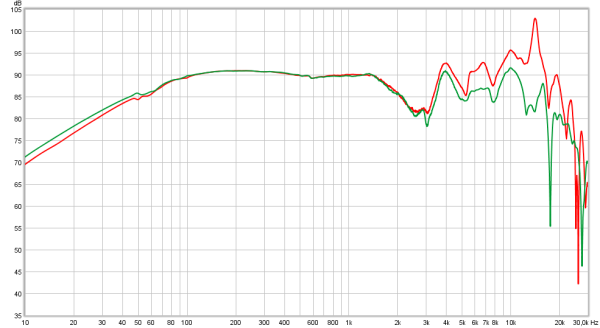 This made the sound more enjoyable and even improved the stereo imaging a bit as the upper treble from the ‘front’ of the ears was not attenuated.
This made the sound more enjoyable and even improved the stereo imaging a bit as the upper treble from the ‘front’ of the ears was not attenuated.
Below the difference in phase response (stock and modified) for the left channel.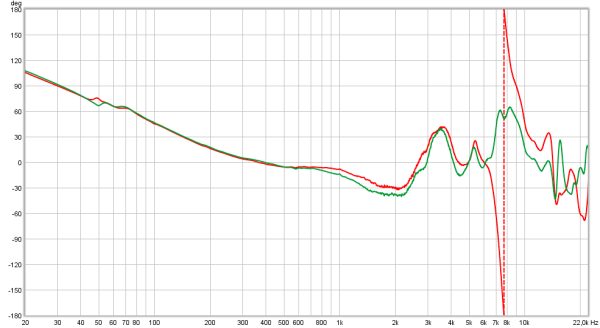 And the difference in step response below.
And the difference in step response below.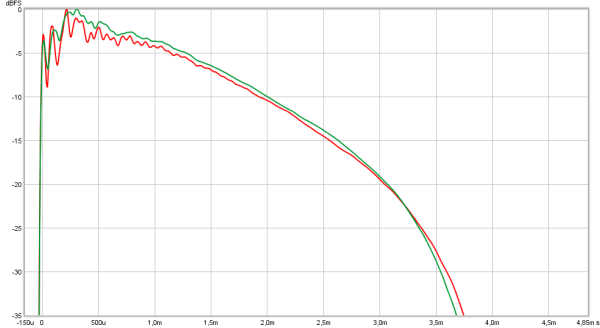 The ringing amplitude and length improved and so did the tonal response improve.
The ringing amplitude and length improved and so did the tonal response improve.
Below the CSD of the left driver (modified) Resonances are much shorter and lower in amplitude.
Resonances are much shorter and lower in amplitude.
Below the frequency response of the modified ATH-AD700X (left, right)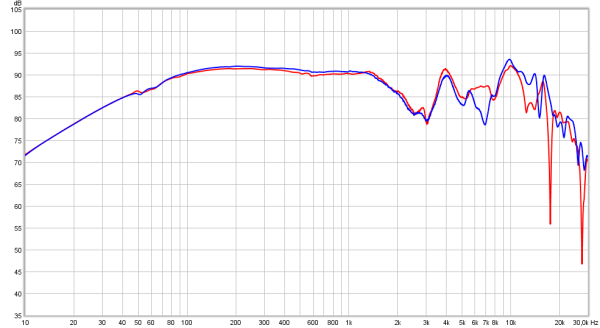 This modification is completely reversible and only requires removing the pads and using some 3mm thick wool-felt (crafts store) and a bit of adhesive plaster to ensure the felt does not wander around when the pads are re-installed.
This modification is completely reversible and only requires removing the pads and using some 3mm thick wool-felt (crafts store) and a bit of adhesive plaster to ensure the felt does not wander around when the pads are re-installed.
conclusion
The ATH-AD700X is not a neutral headphone. It has a distinct and somewhat ‘off’ tonal balance, lacks lower bass and has some sharpness with certain recordings. The latter can be improved with a simple modification if the sharpness is something that bothers you. EQ can not achieve the same effect.
Lower bass can be improved with EQ as the driver does not have a high distortion.
The AD700X can also be used from receivers (old and new) that have a headphone out connector in which case the sound may be somewhat warmer/fuller without sounding muddy.
As the cable is fixed and has a 3.5mm TRS jack the ATH-AD700X cannot be used from balanced amps.
The 3m long and ‘springy’ cable suggests home usage. When using it portable one would have to do something about the long cable. It certainly can be driven directly from portable devices and play quite loud.
The wing system works different than normal headbands and may not work equally well for everyone. This will depend on head shape and size. The fact that the cups can not tilt is a real let down and I would even call it a design omission/error. Sadly the much better sounding ATH-R70X has the same issues.
There are certainly better sounding open headphones to be found in this price class.
When looking in the audio-technica line a much better, but 50% more expensive, open headphone with a similar look but better bass extension and tonal balance is the ATH-R70X.
The R70X also has the same ‘cannot tilt the cups’ issue.

Hey,
love the reviews.
I see you have mentioned r70x in the review yet have never reviewed them here.
It is amongst the better sounding ones at the price range along with 6xx and sundara.
Are you planning on adding them to the audio techina roster in the future?
Much love man.
The R70X is somewhat comparable to the HD600 in sound.
I am not going to buy them as the mechanical construction is the same as that of the AD700 (no ’tilt’ adjustment) which makes them not a ‘good enough’ headphone for me.
When someone sends one in for measurements I will review it though.